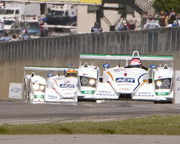Rallying
Rallying, or rally racing, involves two classes of car. The modified Group A, but road legal, production based cars and the Group N Production cars compete on (closed) public roads or off-road areas run on a point-to-point format where participants and their co-drivers "rally" to a set of points, leaving in regular intervals from start points. A rally is typically conducted over a number of "special stages" of any terrain, which entrants are often allowed to scout beforehand at reduced speeds compiling detailed shorthand descriptions of the track or road as they go. These detailed descriptions are known as "pace notes." During the actual rally, the co-driver reads the pace notes aloud (using an in-helmet intercom system) to the driver, enabling them to complete each stage as quickly as possible. Competition is based on lowest total elapsed time over the course of an event's special stages, including penalties.
The top series is the World Rally Championship (WRC), but there also regional championships and many countries have their own national championships. Some famous rallies include the Monte Carlo Rally, Rally Argentina, Rally Finland and Rally GB. Another famous event (actually best described as a "rally raid") is the Paris-Dakar Rally. There are also many smaller, club level, categories of rallies which are popular with amateurs, making up the "grass roots" of motor sports.
Targa Racing (Targa Rally)
Targa is a tarmac-based road rally which is run all around the world. This began with the Targa Florio. There are many races including Targa Tasmania held on the island state of Tasmania, Australia, run annually since 1992. The event takes its name from the Targa Florio, a former motoring event held on the island of Sicily. The competition concept is drawn directly from the best features of the Mille Miglia, the Coupe des Alpes and the Tour de Corse. Other events around the world include the Targa Newfoundland based in Canada, Targa West based in Western Australia, Targa New Zealand and other smaller events.
Drag racing
In drag racing, the objective is to complete a given straight-line distance, from a standing start, ahead of a vehicle in a parallel lane. This distance is traditionally ¼ mile (400 m), though 1/8 mile (200 m) has become popular since the 1990s. The vehicles may or may not be given the signal to start at the same time, depending on the class of racing. Vehicles range from the everyday car to the purpose-built dragster. Speeds and elapsed time differ from class to class. Average street cars cover the ¼ mile in from 10 to 15 seconds whereas a top fuel dragster takes 4.5 seconds or less, reaching speeds of up to 530 km/h (330 mph). Drag racing was organized as a sport by Wally Parks in the early 1950s through the NHRA (National Hot Rod Association), the largest motorsports sanctioning body in the world. The NHRA was formed to discourage street racing.
Launching, a top fuel dragster will accelerate at 4.5 g (44 m/s²), and when braking parachutes are deployed the deceleration is 4 g (39 m/s²), more than the Space Shuttle experiences. A top fuel car can be heard over 8 miles (13 km) away and generates a reading of 1.5 to 2 on the Richter scale.[3]
Drag racing is two cars head-to-head, the winner proceeding to the next round. Professional classes are all first to the finish line wins. Sportsman racing is handicapped (slower car getting a head start) using an index (a lowest e.t. allowed), and cars running under (quicker than) their index "break out" and lose. The slowest cars, bracket racers, are also handicapped, but rather than an index, they use a "dial-in". Bracket racing has been viewed as the main cause of the loss of public interest in drag racing. People don't understand why the slower car wins or why somebody needs to hit the brakes to avoid going too fast. Many local tracks have also complained that bracket racers will also go out of their way to spend as little as possible while at the track by bringing their own food, beverages, fuel and supplies thus, making it more difficult for tracks to make money on these events. This causes gate prices to rise and tracks losing interest in having such events.

In sports car racing, production versions of sports cars and/or grand tourers, and sports prototype cars compete within their respective classes on closed circuits. The races are often conducted over long distances, at least 1000 km, and cars are driven by teams of two or three drivers (and sometimes more in the US), switching every few hours. Due to the performance difference between production-based sports cars and purpose-built sports prototypes, one race usually involves several racing classes. In the US the American Le Mans Series (ALMS) was organized in 1999, featuring GT1, GT2, and two prototype classes, LMP1 (Le Mans Prototype 1) and LMP2. Manufacturers such as Audi and Acura/Honda field or support entries in the Prototype class. Another series based on Le Mans began in 2004, the Le Mans Endurance Series, which included four 1000 km races at tracks in Europe. A competing body, Grand-Am, which began in 2000, sanctions its own endurance series the Rolex Sports Car Series.
Famous sports car races include the 24 Hours of Le Mans, the 24 Hours of Daytona, 24 Hours of Spa-Franchorchamps, the 12 Hours of Sebring, and the 1,000-mile (1,600 km) Petit Le Mans at Road Atlanta.


No comments:
Post a Comment